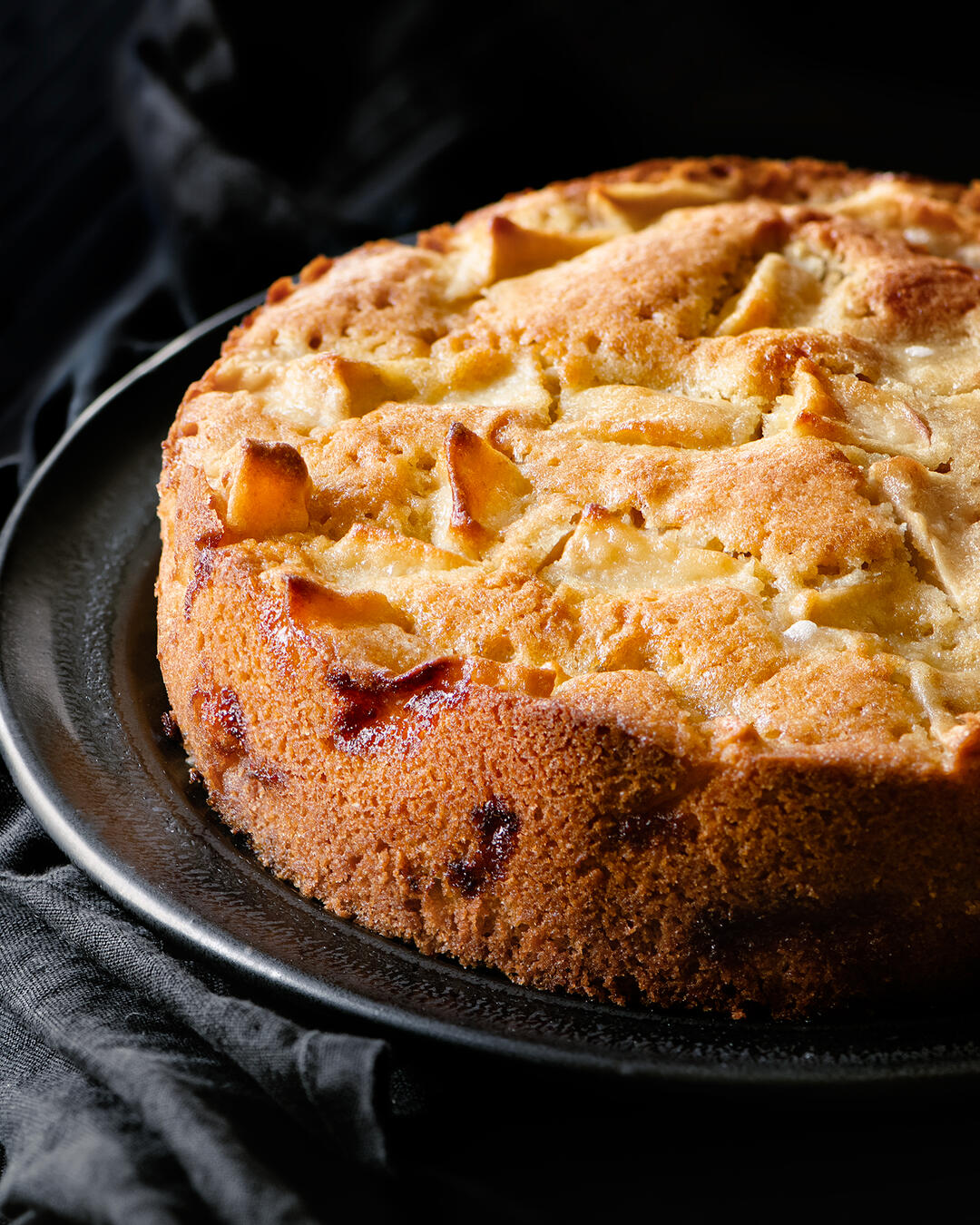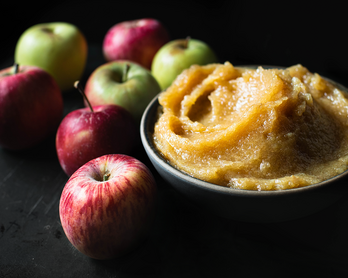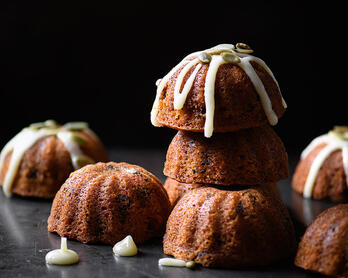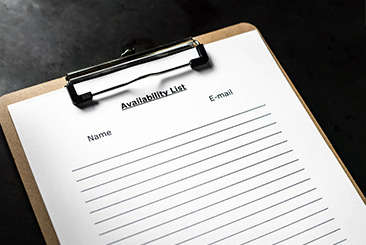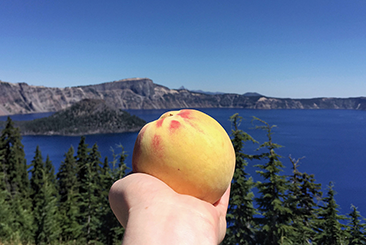French Apple Cake
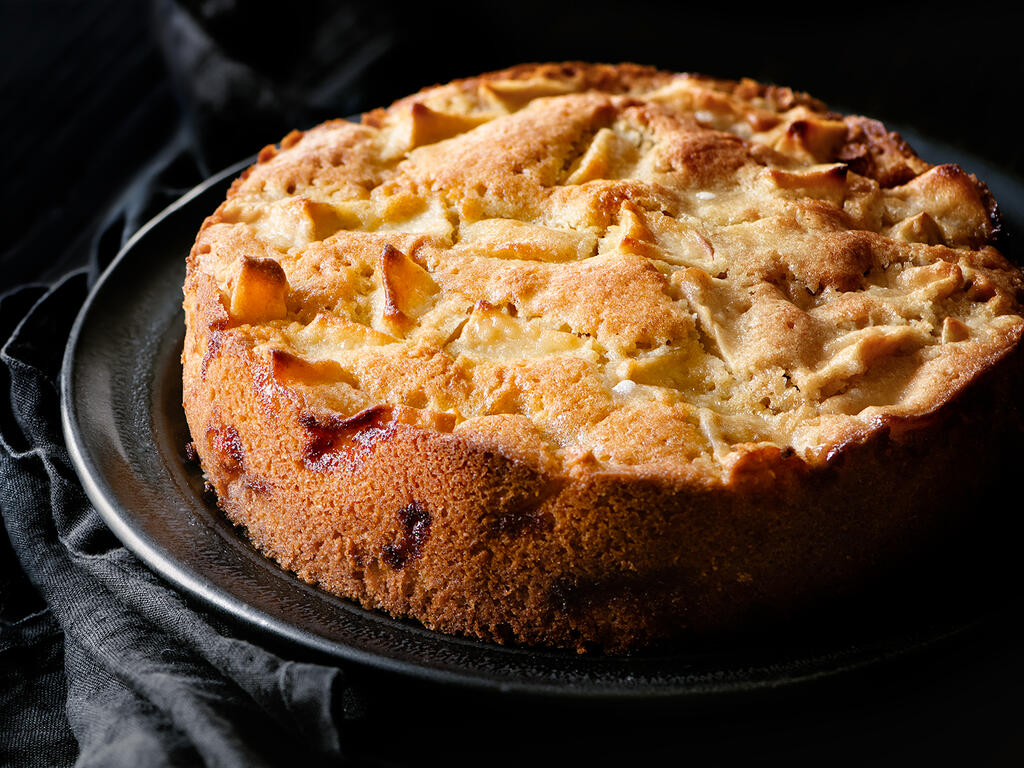
A few years ago, one of my flour shipments from Grist & Toll included a relatively simple recipe for whole grain French Apple Cake. The G&T version was adapted from David Lebovitz who it turns out credited Dorie Greenspan's cookbook, Around My French Table. That's a solid lineage.
French Apple Cake is a roughly 1 to 4 ratio of flour to apples so the perfume of autumn is soaked into every bit of crumb. It's an ideal showcase for apples at their most beautiful and I've already made a gently adapted version several times this season. A bonus is that it works as a make ahead dessert since the flavor is even better on day two.
In terms of my version, I stuck with Grist & Toll's addition of whole grain. Using 100% all-purpose flour leaves a flavor gap where you need a bridge between the cake's three major components. A touch of lemon zest was also folded in because citrus plus butter and apples is cookery magic. Additional notes under Original vs. Adapted.
Around The Dinner Table
Infinity, It Is An Apple Peel
I Googled this a couple of times because I thought the internet was spinning tall tales, and now I find myself pondering scale and physical space.
The Guinness World record for the longest apple peel is held by Kathy Walfer from Rochester, NY. In 1976, she peeled an apple for over 11 hours and 30 minutes and ended up with a continuous peel length of 172 feet and 4 inches. She was 16 years old at the time and apparently grew up to be a manager for an apple tree nursery.
Wild Child
Inside each apple seed of every single apple that has ever existed, lies the potential for uniqueness. - A Life of Apples
The ubiquitous image of a Red Delicious apple belies the fascinating genetics of the fruit. In a nutshell, every apple seed can and often does produce a radically different tree from its parent. Consider that there a 5-8 seeds in an apple which is then multiplied by hundreds of apples per season. This means a single tree can potentially produce thousands of entirely different offspring in one season.
More than any other single trait, it is the apple’s genetic variability—its ineluctable wildness—that accounts for its ability to make itself at home in places as different from one another as New England and New Zealand, Kazakhstan and California. - Michael Pollan, The Botany of Desire
The genetic diversity of apple trees is called "extreme heterozygosity". If you plant a handful of Red Delicious seeds, they can yield trees that produce sour apples or apples with a completely different shape or color. The offspring may have few if any of the Red Delicious traits (that would probably be a good thing...but I digress). This also means that the only way to duplicate an apple tree is to clone it. If you have a kickin' pippin in your garden, you would be well advised to clone that tree or risk losing whatever fruit it produces forever if it dies. A side note is that humans also display heterozygosity but not to to the same degree as apples. Babies generally have a strong resemblance to one or both parents.
We humans have taken to cloning the varieties we like and then planting row after row of said apples.
Diversity fuels sustainability and is a basic tenant of ecology...as we continue to graft the same thing over and over again (just yesterday, I learned that 60% of all apple trees planted in New York State are Macintosh), we are hindering any co-evolution for disease and pest resistance. We growers become more reliant on chemicals to produce a crop as nature evolves around us and becomes increasingly resistant to what we throw at her. - Eliza Greenman
A lack of diversity isn't working out so well for the Cavendish banana. Fruit for thought.
Additional Listening
One of my favorite podcasts, Gastropod, has an episode on apples that's worth a listen. From Johnny Appleseed to cider, there is plenty to bite into.
Recipe Tips
Mix & Match
From Honey Roasted Applesauce to French Apple Cake, mixing and matching apple varieties provides balance in terms of sweetness, acidity, and texture. Mike Cirone of See Canyon arranges his table from tart to sweet so I usually choose a mix from the middle range - Pink Lady, Jonalicious, Jonagold, Gold Rush, Golden Delicious, and others. I've also used Honeycrisp when traveling since that variety is often available at grocery stores.
Kenji Lopez-Alt tested 10 apple varieties over on Serious Eats and noted that acidity helps apples resist oxidation and maintain firmness when baked. Another reason to mix apples that have a good balance of sweet and tart. A lack of acidity and salt is often where baked goods lose their way.
Sifting
This is a fussy step that I include in just about every recipe where flour and other dry goods are included - All-butter Pie Dough, Fresh Ginger Cake, Sourdough Pancakes, and Pumpkin Tea Cake are examples. It eliminates lumps, lightens the texture of the flour, and evenly distributes additions such as baking powder, salt, and cinnamon. I read opinions on the subject from around the internet and folks don’t seem to agree (how shocking). My baked goods usually have a nice texture and sifting seems logical to me so I'm sticking with it.
It's worth noting that sifting can change the volume of flour which is another supporting point for weighing ingredients. Your scale is your forever baking buddy.
Butter
I previously discussed how fat has a diluting effect on taste. That small bit of knowledge has had a lot of influence on how I approach sweet and savory dishes. I use salted butter in just about everything these days because I find most baked goods don't have enough of a sodium punch.
This French Apple Cake has both eggs and butter so I prefer to use salted butter to play counterpoint to the sugar. With that said, the ingredient list below suggests using 50% salted and 50% unsalted butter since salt content varies widely between brands. Adjust as you see fit.
Pan Size
A number of recipes suggest using an 8-inch or 9-inch springform pan but Dorie Greenspan's recipe calls for an 8-inch. I've baked several French Apple Cakes and prefer the structure, slightly longer baking time, and height that an 8-inch pan offers (pictured).

Original vs. Adapted
Rum
Rum is a powerful ingredient and I found 2 tablespoons plus 1 teaspoon (reduced from 3 tablespoons) was impactful but still allowed the apples to shine. It's your call if you want to lean into the boozy edge with 3 tablespoons.
A number of French Apple Cake recipes around the internet call for spiced rum. I've used dark and spiced rum and can't say that I have a preference between the two.
Sugar & Spice
I reduced the sugar from 150 grams (5 1/4 ounces) to 130 grams (4 1/2 ounces) and added a touch of cinnamon for warmth. David Lebovitz mentions in his recipe that he resisted his American inclination to add cinnamon because then the cake would not be "authentically French." I've made the cake with and without cinnamon and they were both delicious so it's up to you.
Citrus
When in doubt, add lemon (or orange). I turn to citrus frequently in both savory and sweet dishes. A bit of lemon zest amplified all of the flavors in the cake.
Farmers | Artisans
I make an effort to source my food from California artisans with a special focus on the Santa Monica Farmers Market. Below is a list of the folks who contributed to this dish.
- Central Milling / Organic Beehive All-Purpose Flour
- Grist & Toll / Whole Grain Spelt, Sonora Flour, or Wit Wolkoring
- Mike Cirone - See Canyon / Apples
- Omma's Garden / Eggs
- Polito Family Farms / Citrus
- JJ's Lone Daughter Ranch / Citrus
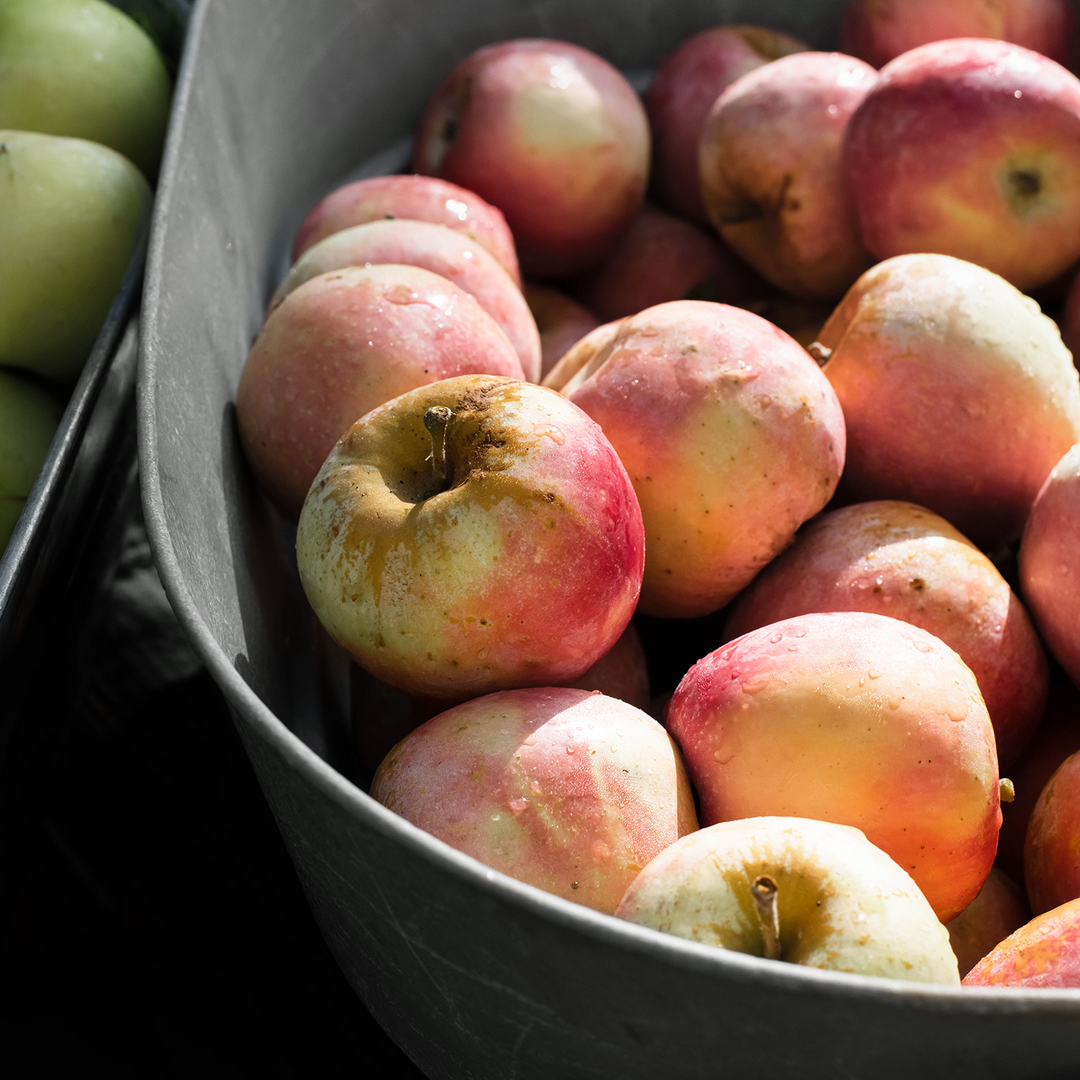
Tools
- OXO Scale - There are two scales in my kitchen. The workhorse is an OXO model that I purchased over 10 years ago and only recently had to replace. RIP scale #1. It's a sturdy cooking companion that repeatedly gets covered in flour, sauce, or whatever else is flying around the kitchen. I recommend keeping liquids away from the screen since they can find their way inside. That being said, the scale seems to dry out and keep on measuring. Note: My original scale with the black pull-out display is now made in all stainless steel. As far as I can tell, the new all stainless version is the same. Watch out for the online sellers who are price-gouging and charging $75 for the older model.
- 8-inch Springform Pan - As mentioned under Recipe Tips, Dorie Greenspan's recipe calls for an 8-inch pan and that's what I prefer. A 9-inch pan will also work.
- All-Clad Fine Mesh Strainer Set - Mesh strainers serve as a flour sifters, rice rinsers, and roasted eggplant drainers.
- Bowls (Medium and Large) - I've had the same set of nested glass bowls since college. The linked items aren't the same but a bowl is a bowl for these purposes.
- Thermapen Digital Thermometer - I have three Thermapen thermometers that are distributed between my home, the Airstream, and my mother-in-law's house. They're fast, easy to clean, and the probe makes a perfect cake tester.
- Cooling Rack - Though I have both wire and mesh cooling racks, I'm partial to the wired since there are less nooks and crannies to clean.
Ingredients
- 8 tablespoons (115 grams) butter - half salted/half unsalted Note: See Original vs. Adapted
- 55 grams whole grain Sonora, Spelt, Wit Wolkoring, or whole grain of your choosing
- 55 grams Beehive all-purpose flour
- 3/4 teaspoon baking powder
- 1/4 teaspoon Diamond kosher salt
- 1/4 teaspoon + 1/8 teaspoon cinnamon
- 4 large apples, mix (460 grams/16 ounces after prep)
- 2 eggs, room temperature
- 130 grams (4 1/2 ounces) granulated sugar
- 2 tablespoons + 1 teaspoon dark rum
- 1/2 teaspoon vanilla
- 1/2 teaspoon gently packed lemon zest
Instructions
Mise en Place
- Line a baking sheet with foil and set aside.
- Generously butter an 8-inch springform pan, line the bottom with a cut-to-fit piece of parchment (it will stick neatly to the pan), butter the parchment, then set aside. See Recipe Tips regarding pan size.
- Set your eggs out on the counter (and apples if in cold storage) and let them come up to room temperature. Gather all of the remaining ingredients together.
- Once the ingredients are assembled and at room temperature, move an oven rack to the middle position then heat to 350°F.
Mix & Bake
- Melt the 8 tablepoons (115 grams) of butter and set aside.
- Place a bowl on top of the scale and then a mesh strainer/sifter on top of that. Tear the scale and add to the sifter 55 grams Sonora/Spelt/other whole grain flour, 55 grams all-purpose flour, then add 3/4 teaspoon baking powder, 1/4 teaspoon Diamond kosher salt, and 1/4 teaspoon + 1/8 teaspoon cinnamon. Whisk briefly then sift, dump any bran flakes back into the pile, then whisk again to combine.
- Peel and dice the apples into 1-inch chunks then set aside - resulting in about 460 grams/16 ounces after prep.
- In a medium bowl, whisk the 2 eggs until foamy. Enjoy that shoulder muscle burn.
- To the eggs, add the 130 grams (4 1/2 ounces) sugar, 1/2 teaspoon vanilla extract, 2 tablespoons + 1 teaspoon rum, and 1/2 teaspoon gently packed lemon zest then give it a hearty whisk to combine.
- Add half of the flour to the egg mixture, whisk until 75% incorporated, then add half of the butter and whisk until almost incorporated. Switch to a rubber spatula. Add the rest of the flour and fold until 75% combined, then add the remaining butter and fold until just combined.
- Add the apple chunks and fold just enough to coat them thoroughly. Scrape the thick batter into the pan and scooch the apple pieces around to evenly distribute.
- Place the pan on your lined baking sheet and bake for 50 to 60 minutes.
- At 30 minutes, turn the pan 180°. The batter will have risen and will be enveloping the apple cubes.
- At 50 minutes, an 8-inch cake is golden brown and 175°F in the center so it needs about 10 to 15 more minutes. When using a 9" pan, the internal temp is 200°F at 50 minutes so it's almost done. Target temperature is 205 to 210°F in the center.
- When done baking, transfer the pan to a wire rack and run a knife around the edge. Let rest for 10 minutes and then carefully remove the outer ring of the springform pan. Watch for any cake or apples that may still be sticking.
- Cool completely before slicing.
Serve
The cake is excellent on its own but a small scoop of vanilla ice cream or dollop of whipped cream (perhaps even crème fraîche whipped cream) never hurts. I use this whipped cream recipe minus the honey but you could certainly leave some honey in.
Storage
Line a plate with a paper towel and then parchment on top to prevent sticking, then cover the whole thing with an inverted bowl and store at room temperature. A proper cake stand would also work great.
Newsletter
Subscribe at the bottom of this page for the Chic Eats roundup. It includes new and updated recipes along with a grab bag of content that was interesting enough to share around the dinner table.
